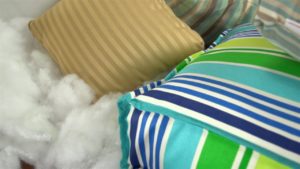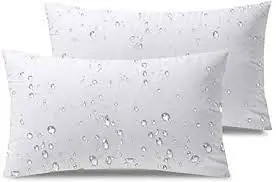Last updated on February 2nd, 2022
Summer. Time to spend more time outdoors. But what happens if you pull your outdoor cushions from their storage only to realize they are saggy and mildewed? What if they are unusable in their current state? Throwing them away is not the answer. Replacing their fill is. The next logical question now is, “what do I use to stuff outdoor pillows?”
You can stuff any outdoor pillows with various weather-resistant or weather-proof materials, including polyester fiberfill, clustered polyfill, compressed polyester, Dacron, Dacron wrap, and the many available types of foam such as open-cell foam, closed-cell foam, polyurethane foam, and dryfast foam recommended for outdoor pillow stuffing.
It does not take a lot of work to make outdoor cushions once you have the suitable materials. The main thing is to choose the right fabrics and stuffing.
Whether you are repairing worn-out outdoor cushions or making fresh new ones, choose specifically from one of the numerous types of outdoor cushion fillers.
Table of Contents
Types of fill to stuff outdoor furniture
Picking the wrong type of stuffing can mean your cushions will develop mold and mildew and get damaged by weather elements. Or, it could also mean they won’t last through a season or two. To simplify your task, we have rounded up a few options here for you to choose from.
Polyester fiberfill
If you are looking for something cheap, non-allergenic, washable, and mold-resistant, you may consider polyester.
These fills consist of blown polyester fibers available in the form of loose filling called fiberfill. Fiberfill is soft, fluffy stuff that is useful for stuffing odd-shaped or round pillows. Usually, you’ll find the polyester fiberfill inside a pre-sewn fabric inserted into a cushion cover.

Pillows stuffed with polyester fiberfill flatten out over time. The more you use them, the more they compress. As such, it is best to use them for accent pillows rather than to provide functional comfort.
Notice that polyester stuffing absorbs water. You, therefore, need to tuck them inside a water-repellent fabric or ensure you dry them out before use in case of a spillage or if they are rained on.
Thankfully, this fill is resistant to mildew and can be machine washed. You’ll often find the filling damaged after washing. You can fix this damage quickly by smoothing out the insert with your hand.
Clustered polyfill
This outdoor cushion filling material is similar to the polyester we have discussed above, except it is made into tiny balls or wrapped in small bundles. Stuffing the material into these little balls makes the cushions slightly firmer than the ones with polyester fiberfill.
Like fiberfill cushions, clustered polyfill cushions are susceptible to compression and eventually flattening out.
Foam
Foam is one of the most common filling materials for outdoor cushions. It is widely used for medium-firm cushions and comes in a range of densities. These densities act as the basis for grading the foam.
Polyurethane foam soaks up in the water, so it has to be treated to repel mold and mildew. Treating foam makes it ideal for any outdoor use. You can put plastic sheeting beneath the cushion cover to protect it further.
Open-cell foam and closed-cell foam are the two main types. The former (open-cell foam) is durable and has large open pores that allow water to pass through without absorbing much of it.
Closed-cell foam lacks open pores, as the name suggests. It is pretty firm and does not absorb water. Its structure makes it buoyant and rigid. Most floatation devices contain this kind of foam because of its buoyant, waterproof nature. You will also find closed-cell foam in other specialty applications.
Compressed polyester and polyurethane foam
Compressed polyester resembles foam and provides a close alternative to it (foam). Even though it compresses with time, it does not break down or yellow like traditional foam.
Like fiberfill, compressed polyester is non-allergenic and mildew resistant. It is entirely washable and dries quickly by air – making it great for patio seating.
Similarly, polyurethane foam works well for outdoor seating because it is treated with specific chemicals. These biocides help prevent the growth of mold, mildew, and fungus.
Like any foam, the polyurethane foam must be cut to fit the dimensions of the specific pillow. You can also cover the foam in a plastic material before inserting it into the pillow cover for added safety.
Dacron
Dacron or polyethylene terephthalate (PET) is a foam padding insert that provides optimal support due to its excellent durability. It is a type of patented fiberfill technology for synthetic polymer resin that was originally used in making luxury beds.
Today Dacron is used in cushions. Dacron cushions are ideal for purposes of practical support because they do not flatten out like other cushion materials. This filling material is quite firm, which gives your outdoor pillows a tight, well-kept appearance.
Dacron patio cushion inserts are typically wrapped in a thin layer of polyester to give the cushion a softer feel that is great for any outdoor use.
Dacron wrap
Foam cushions are sometimes wrapped in a layer of Dacron to give them a more excellent look. These are termed Dacron-wrapped cushions, and they have a better feel than pure foam.
Notice that Dacron-wrapped cushions are just that: cushion inserts wrapped in a layer of Dacron before putting them inside the cover. These cushions typically have a one, or half-inch layer of Dacron added to the cushion’s exterior.
Dacron-wrapped cushions use much less Dacron but have a better-looking crown than foam cushions that appear somewhat flat. Because the Dacron later is thin, the cushions can flatten out like other foam cushions over time.
Beanbag fill
If you think that beanbag fill is not a popular choice for outdoor seating, then you are right. Beanbags are traditionally more commonly used indoors than outdoors. However, having a beanbag for a daybed around your deck can be such an addictive way to enjoy the sun.

Beanbag chairs are mostly filled with EPS beads. EPS is comprised of 98-percent air and is resistant to heat and moisture. These fillers are incredibly lightweight and rigid, which makes them an excellent choice for outdoor seating.
You’ll be happy to know that you can add more EPS beads to stuff the seat as needed without replacing the entire seat.
Factors to consider when choosing a fill for outdoor pillows
Outdoor cushions need materials that are quick-drying and mold-resistant. These are the primary considerations to keep in mind when choosing a filler for your outdoor pillows.
When you wash your outdoor pillows, a quick-drying material will be ready for use after only a few hours of air drying. This means you do not have to sacrifice your outdoor comfort for too long.
Replacing your pillows before the filling is fully dry can cause it to rot and deteriorate quickly. Such moisture could provide a foothold for mold and mildew, even for materials that are resistant to these fungi.
Water-resistant vs. waterproof outdoor pillow inserts material.
I often see people use the terms waterproof and water-resistance interchangeably. That shouldn’t be the case, as the two terms are not synonyms.

Water-resistant fabric is one with the ability to repel water that drops on it. Usually, this is because the material has been treated with a particular type of coating or chemical. Deep a water-resistant pillow in water, and it will soak it up.
A waterproof material does not absorb water. It doesn’t matter whether you dunk it in water or you throw a drop on it.
Some cushion fillings are designed with sufficient air spaces that help keep them from soaking up if you dip them in water. Such a material is a good choice for outdoor use because it is likely to withstand moisture and prevent mold and mildew from forming.
Cost vs. quality
Something like polyester fiberfill will be much cheaper upfront but will flatten out with use. This means it will not offer much long-term value.
On the other hand, Dacron will be expensive to buy, but it helps you save money in the long run because it is durable.
When shopping for stuffing material for your outdoor cushions, you want to weigh out these two considerations and see what will work best for you. Think about how you intend to use the pillows. If, for instance, you intend to use them as accent pillows, then a cheap fill like polyester will do. Otherwise, go for something more expensive but durable and cost-effective in the long run.
What kind of foam do you use for outdoor cushions?
Outdoor use requires foam that will withstand elements of weather. Multiple types of foam fit this profile.
Polyurethane foam
This is one of the most common choices of foam for outdoor cushions. It is quite porous, which allows water to flow through it. You can choose your ideal firmness from the wide range available.
Polyurethane foam filling has been in use for decades for both couches and mattresses. It is not resistant to water but is usually treated with a unique biocide to prevent mold growth and mildew in it.
Some companies also cover the foam with plastic wrap before putting it inside the cushion. Whatever the case with your polyurethane foam, you may want to avoid using it near a pool or in places that experience a lot of rain.
This type of foam can be a good choice, though, due to its affordability.
Open-cell foam
Like polyurethane form, open-cell form has open pores that allow for free circulation of water and air. Given the pores, an open-cell foam will dry very quickly, allowing you to use it soon after washing or being rained on.
The foam comes treated with a mold and mildew spray that prevents both fungal and bacterial growth. It is quite resistant to the elements, meaning you can use it outdoors in any weather without any problems.
When you use it in pillows, this fill provides a relaxed and pleasant seating experience.
The only downside is that open-cell foam tends to be pricey. But like most people, you will likely find it worth the amount.
Closed-cell foam
As the name suggests, closed-cell foam has no pores in its cells. The cells are closed and do not allow any water to run through them.
This kind of foam is entirely waterproof and will float in water if you throw it in. This explains why closed-cell foam is used in life vests found on airplanes and seating on commercial boats.
Closed-cell foam is three times firmer than polyurethane foam. Therefore, you can use it for a long time without becoming compressed and flattening out into a thin membrane.
Of course, that durability also means this type of filling will cost you more money than polyurethane foam. It will be an ideal choice, though, if you live in a place where heavy rains are a phenomenon.
Closed-cell foam can be paired with Dryfast foam for added comfort and support. This combination requires holes to be cut through the closed-cell foam to allow water to drain through whenever that is necessary.
Dryfast foam
It is a foam with an open-cell structure designed to permit air and moisture to pass through more freely than other foam types. Given this unique structure, dryfast foam will dry much quicker.
Dryfast foam boasts superior antimicrobial properties that prevent the growth of bacteria, mold, and mildew.
It is pretty versatile and can be used for a variety of outdoor applications. You may choose from various thickness options ranging from 1-inch to 6 inches.
All the available thicknesses can be carved into any shape to fit the respective outdoor application.
Conclusion
The kind of stuffing you choose for your outdoor cushions can make or break your upholstery project.
The right fill for your pillows will help you transform even a tired-looking, uninviting outdoor space into something vibrant and lively.
We hope this guide will help you answer the question ‘what do I use to stuff outdoor pillows’ and make your purchase decision easier and stress-free.
Frequently Asked Questions.
What is the best fill for outdoor cushions?
Both standard and deluxe poly-fibre fill are ideal for outdoor bench cushions, chaise lounge cushions, or any other outdoor piece of furniture.
Nonetheless, your budget and specific outdoor cushion requirements will still come into play to determine what type of fill will be truly ideal for you.
Can you stuff pillows with plastic bags?
Absolutely. Plastic bags make a cheap and recyclable option for stuffing your outdoor pillows or outdoor pillow inserts. To use these, gather your plastic bags. Identify one about the size of your selected pillow cover. Spread out each of the stuffing bags before rolling them loosely and placing them inside the big bag you chose. This part will ensure that your pillow has a smooth, natural feel.
The idea is to keep each stuffing bag lined to allow the outer bag to stay as smooth as possible. Once you are done filling it, you’ll need to staple it closed and insert it in your pillow cover.
What type of foam is used for outdoor cushions?
There are several types of foams that can be used for outdoor cushions such as floatation foam, polyester fiberfill, Urecel quick dry foam, polyurethane foam, dry fast foam, and open cell foam. However, the best among these is the dry fast foam due to its versatility.
What material is used for outdoor pillows?
The best fabric material for outdoor pillows is polypropylene fabric because of its superior UV-resistant nature compared to most fibers. This material dries faster and does not leave dye marks or sites after drying.
Can cotton canvas be used outdoors?
Cotton has been used for years in outdoor cushions due to its affordability, comfort, and accessibility. However, it is important to know that cotton is more prone to fading and mildew, so you need to treat it before using it.
Is compressed polyester for outdoor cushions good?
Yes. Compressed polyester is an alternative to foam which lasts longer since it doesn’t crumble and fade when used for long. It is more cost-effective and can be used on cushions used regularly.


